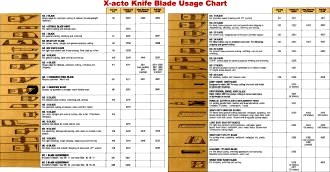
I've been using X-acto tools since my teenage years the early
1970s. Before that, my razor knife blades were either the single-edge hardware
store type or double-edge blades copped from my father's safety razor (those
were truly dangerous, even with one edge taped). Half a century later, I now
have a selection of many flavors of X-actor blades and handles. As the chart
above shows, there seems to be an X-acto blade for every purpose. I often
wondered what they were all meant for, until I found this X-acto Blade Usage
Chart from the
company. Like most people, by far my most often used blade is the trusty #11.
I've been through hundreds of them. X-acto also makes a wide variety of
specially shaped carving blades, including vees, cups, circles (routers), and
gouges.
Anyway, if you were ever wondering what all those X-acto blade shapes are for,
wonder no longer. Just today I used a 1/2" diameter router blade to hollow out part of a balsa block
in the Cessna 336 Skymaster control line model I'm building.
The history of X-ACTO
(aka x-acto, aka X-acto) begins in the early 20th century with the innovative vision
of its founder, Sundel Doniger. Doniger, a Jewish immigrant from Poland, initially
pursued a career in the medical field as a physician. He founded X-ACTO in 1930,
originally intending to produce surgical scalpels and other precision medical instruments.
The company's name reflects this early focus, deriving from the idea of "exact"
cuts and precision. Headquartered in New York City, the company began operations
in modest facilities designed to produce specialized cutting tools.
The breakthrough moment for X-ACTO came when Doniger realized the potential for
his precision blades beyond medical applications. The company's first iconic product,
the X-ACTO knife, was introduced as a general-purpose precision cutting tool. Its
design featured a slender metal handle and replaceable sharp blades capable of intricate
cuts. This tool quickly gained popularity among graphic artists, architects, and
hobbyists, who found it indispensable for tasks requiring accuracy and fine detailing.
During its early years, X-ACTO knives were sold primarily through art supply stores,
trade catalogs, and advertisements targeting professional craftsmen and artists.
As demand for the product grew, X-ACTO expanded its product line to include various
blade types, such as straight and curved options, catering to a broader range of
cutting needs. By the mid-20th century, the company had relocated to larger manufacturing
facilities in New Jersey to meet growing production demands. It also diversified
its offerings to include additional cutting tools, such as precision saws, shavers,
and comprehensive tool kits that served professional and hobbyist markets alike.
These products found uses in model-making, drafting, woodworking, and other crafts,
solidifying X-ACTO as a versatile brand in the precision tool industry.
X-ACTO's advertising strategies in its early years relied heavily on trade publications
and targeted media, ensuring visibility among its core audience of professionals
and enthusiasts. By the 1950s, its products were increasingly available in mainstream
retail outlets such as hardware stores and department stores, broadening the brand's
reach to general consumers. The company's reputation for quality and reliability
made X-ACTO tools a staple in schools, offices, and homes.
The company underwent significant changes in ownership and structure over the
decades. In the 1960s, X-ACTO was acquired by the Berol Corporation, a manufacturer
of writing instruments and other office supplies. Under Berol, X-ACTO's product
lines continued to expand, and its distribution network grew significantly. This
era also saw a focus on promoting X-ACTO products as essential tools for education
and creativity, further embedding the brand in the consumer market.
In 1995, Berol and its X-ACTO division were acquired by Newell Rubbermaid, a
global consumer goods conglomerate. This acquisition integrated X-ACTO into a larger
portfolio of office and school supply brands, providing it with access to Newell
Rubbermaid's extensive resources and global distribution channels. The brand remained
a leader in precision cutting tools, with its products evolving to incorporate ergonomic
designs and enhanced safety features.
In the 21st century, X-ACTO continued to innovate and diversify its offerings.
The product range grew to include electric pencil sharpeners, cutting mats, and
other complementary tools for precision work. The company also embraced digital
marketing and e-commerce, ensuring its products remained accessible to a global
audience. Present-day X-ACTO products are manufactured in facilities around the
world, maintaining the brand's commitment to quality and precision. They are sold
through major retailers, including Amazon, Walmart, and specialized art and craft
stores.
X-ACTO is now a part of the Elmer's Products division within Newell Brands, the
successor to Newell Rubbermaid after its 2016 merger. Elmer's Products focuses on
adhesives, crafting supplies, and tools, making X-ACTO a vital component of its
portfolio. Although specific revenue figures for X-ACTO are not publicly disclosed,
its continued prominence in the precision tools market reflects its enduring success.
The brand remains synonymous with precision and reliability, serving a diverse range
of applications from professional industries to creative hobbies.
|



